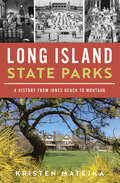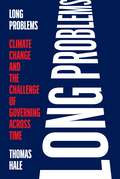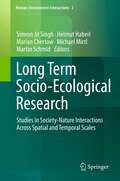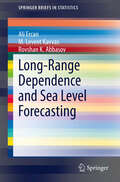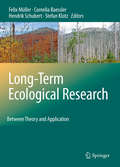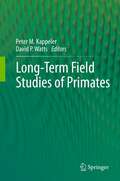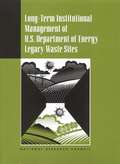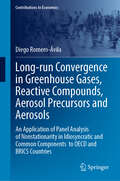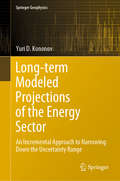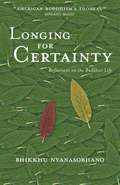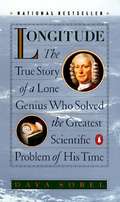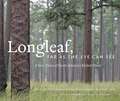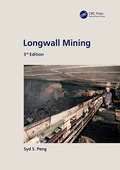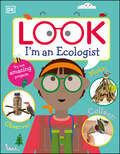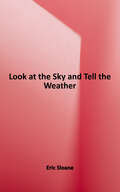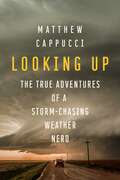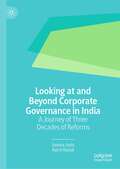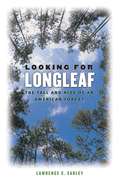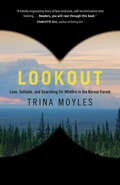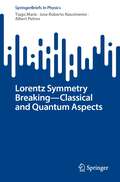- Table View
- List View
Long Island State Parks: A History from Jones Beach to Montauk (Landmarks)
by Kristen MatejkaDiscover the History Behind the Beauty of Long Island's Most Cherished Parks Each year, tens of millions of people visit Long Island's state parks. Most visitors are unaware that each one of the state parks has its own fascinating chapter in the region's storied history. Some were once vast estates of New York's elite during the turn-of-the-century Gilded Age, such as Planting Fields Arboretum State Historic Park. Others were "hunting clubs," where wealthy members banded together to create retreats, including Caleb Smith State Park Preserve. Montauk's Camp Hero has a multigenerational military history, even inspiring conspiracies that the government experimented with mind control and time travel. Underprivileged children from the bustling boroughs of New York City found fresh air and formative experiences at Camp William Carey in today's Hallock State Park Preserve. Author Kristen Matejka presents the hidden history of the New York state parks on Long Island.
Long Problems: Climate Change and the Challenge of Governing across Time
by Thomas HalePolitical strategies for tackling climate change and other &“long problems&” that span generationsClimate change and its consequences unfold over many generations. Past emissions affect our climate today, just as our actions shape the climate of tomorrow, while the effects of global warming will last thousands of years. Yet the priorities of the present dominate our climate policy and the politics surrounding it. Even the social science that attempts to frame the problem does not theorize time effectively. In this pathbreaking book, Thomas Hale examines the politics of climate change and other &“long problems.&” He shows why we find it hard to act before a problem&’s effects are felt, why our future interests carry little weight in current debates, and why our institutions struggle to balance durability and adaptability. With long-term goals in mind, he outlines strategies for tilting the politics and policies of climate change toward better outcomes.Globalization &“widened&” political problems across national boundaries and changed our understanding of politics and governance. Hale argues that we must make a similar shift to understand the &“lengthening&” of problems across time. He describes tools and strategies that can, under certain conditions, allow policymakers to anticipate future needs and risks, make interventions that get ahead of problems, shift time horizons, adapt to changing circumstances, and set forward-looking goals that endure. As the climate changes, politics must, too. Efforts to solve long-term problems—not only climate change but other issues as well, including technology governance and demographic shifts—can also be a catalyst for a broader institutional transformation oriented toward the long term. With Long Problems, Hale offers an essential guide to governing across time.
Long Term Socio-Ecological Research: Studies in Society-Nature Interactions Across Spatial and Temporal Scales
by Martin Schmid Helmut Haberl Marian Chertow Michael Mirtl Simron Jit SinghThe authors in this volume make a case for LTSER's potential in providing insights, knowledge and experience necessary for a sustainability transition. This expertly edited selection of contributions from Europe and North America reviews the development of LTSER since its inception and assesses its current state, which has evolved to recognize the value of formulating solutions to the host of ecological threats we face. Through many case studies, this book gives the reader a greater sense of where we are and what still needs to be done to engage in and make meaning from long-term, place-based and cross-disciplinary engagements with socio-ecological systems.
Long-Range Dependence and Sea Level Forecasting
by Ali Ercan M. Levent Kavvas Rovshan K. AbbasovThis study shows that the Caspian Sea level time series possess long range dependence even after removing linear trends, based on analyses of the Hurst statistic, the sample autocorrelation functions, and the periodogram of the series. Forecasting performance of ARMA, ARIMA, ARFIMA and Trend Line-ARFIMA (TL-ARFIMA) combination models are investigated. The forecast confidence bands and the forecast updating methodology, provided for ARIMA models in the literature, are modified for the ARFIMA models. Sample autocorrelation functions are utilized to estimate the differencing lengths of the ARFIMA models. The confidence bands of the forecasts are estimated using the probability densities of the residuals without assuming a known distribution. There are no long-term sea level records for the region of Peninsular Malaysia and Malaysia's Sabah-Sarawak northern region of Borneo Island. In such cases the Global Climate Model (GCM) projections for the 21st century can be downscaled to the Malaysia region by means of regression techniques, utilizing the short records of satellite altimeters in this region against the GCM projections during a mutual observation period. This book will be useful for engineers and researchers working in the areas of applied statistics, climate change, sea level change, time series analysis, applied earth sciences, and nonlinear dynamics.
Long-Term Ecological Research
by Felix Müller Cornelia Baessler Hendrik Schubert Stefan KlotzEcosystems change on a multitude of spatial and temporal scales. While analyses of ecosystem dynamics in short timespans have received much attention, the impacts of changes in the long term have, to a great extent, been neglected, provoking a lack of information and methodological know-how in this area. This book fills this gap by focusing on studies dealing with the investigation of complex, long-term ecological processes with regard to global change, the development of early warning systems, and the acquisition of a scientific basis for strategic conservation management and the sustainable use of ecosystems. Within this book, theoretical ecological questions of long-term processes, as well as an international dimension of long-term monitoring, observations and research are brought together. The outcome is an overview on different aspects of long-term ecological research. Aquatic, as well as terrestrial ecosystems are represented.
Long-Term Field Studies of Primates
by Peter M. Kappeler David P. WattsSome primate field studies have been on-going for decades, covering significant portions of individual life cycles or even multiple generations. In this volume, leading field workers report on the history and infrastructure of their projects in Madagascar, Africa, Asia and South America. More importantly, they provide summaries of their long-term research efforts on primate behaviour, ecology and life history, highlighting insights that were only possible because of the long-term nature of the study. The chapters of this volume collectively outline the many scientific reasons for studying primate behaviour, ecology and demography over multiple generations. This kind of research is typically necessitated by the relatively slow life histories of primates. Moreover, a complete understanding of social organization and behaviour, factors often influenced by rare but important events, requires long-term data collection. Finally, long-term field projects are also becoming increasingly important foci of local conservation activities.
Long-Term Institutional Management of U.S. Department of Energy Legacy Waste Sites
by Tank Wastes Committee on the Remediation of BuriedA report on the Long-Term Institutional Management of U.S. Department of Energy Legacy Waste Sites
Long-run Convergence in Greenhouse Gases, Reactive Compounds, Aerosol Precursors and Aerosols: An Application of Panel Analysis of Nonstationarity in Idiosyncratic and Common Components to OECD and BRICS Countries (Contributions to Economics)
by Diego Romero-ÁvilaThis book examines the presence of stochastic and deterministic convergence in ten series of greenhouse gases, aerosol precursors, and aerosols across 29 industrialized and emerging countries from 1820 to 2018. The author utilizes the Panel Analysis of Nonstationarity in Idiosyncratic and Common Components (PANIC) method for the empirical exercise. The analysis reveals strong evidence of stochastic convergence patterns in the series of log per capita emissions for black carbon, carbon monoxide, ammonia, non-methane volatile organic compounds, and nitrogen oxides, demonstrated by the existence of pairwise cointegration among individual series. Regarding deterministic convergence, the book provides compelling evidence of convergence in per capita emissions for black carbon, carbon monoxide, ammonia, non-methane volatile organic compounds, nitrogen oxides, and sulfur dioxide. There is also moderate evidence of convergence in per capita emissions for carbon dioxide, nitrous oxide, and organic carbon, and weaker evidence for methane emissions. The findings have significant implications for environmental policy, particularly in light of the observed deterministic convergence in emissions.
Long-term Modeled Projections of the Energy Sector: An Incremental Approach to Narrowing Down the Uncertainty Range (Springer Geophysics)
by Yuri D. KononovThis book covers available approaches to improving the performance and impact of long-term projections of the national energy sector development. In turn, it introduces an original multi-stage approach to narrowing down the uncertainty range of the input data and resulting projections. Its unique contribution is that it limits the scope for each of the projection timeframe segments step-by-step. This is done in the course of iterative calculations, which employ dedicated methods and other tools to elucidate and solve top-priority problems specific to each time segment. In closing, the book provides a detailed treatment of two essential research problems: 1) long-term forecasting for regional energy markets, and 2) the quantitative assessment of a) the barriers that are likely to hinder energy sector development and b) strategic-level energy security threats.
Longing for Certainty
by Bhikkhu NyanasobhanoIn the same lyrical voice that met with such acclaim in Landscapes of Wonder, Bhikkhu Nyanasobhano invites us to look upon the natural world with new eyes and to find the truths of the Buddha's teachings in our immediate experience. Attentive to the subtle power of language, Bhikkhu Nyanasobhano choose his words in these essays with such artisty and care that Longing for Certainty resounds with sparkling, fluid clarity. Bhikkhu Nyanasobhano has been referred to as "American Buddhism's Thoreau" and indeed, his ability to inspire his readers to discover the wonders of nature and the spiritual insights that they arouse is unsurpassed among modern Buddhist writers. Fans of his acclaimed Landscapes of Wonder, will find that Longing for Certainty moves into even deeper fields of reflection.
Longitude: The True Story of a Lone Genius Who Solved the Greatest Scientific Problem of His Time
by Dava SobelBiography of John Harrison, who solved the problem of figuring out what a ship's latitude was, by figuring out how a ship could keep precise time at sea.
Longleaf, Far as the Eye Can See
by John C. Hall Bill Finch Beth Maynor Young Rhett JohnsonLongleaf forests once covered 92 million acres from Texas to Maryland to Florida. These grand old-growth pines were the "alpha tree" of the largest forest ecosystem in North America and have come to define the southern forest. But logging, suppression of fire, destruction by landowners, and a complex web of other factors reduced those forests so that longleaf is now found only on 3 million acres. Fortunately, the stately tree is enjoying a resurgence of interest, and longleaf forests are once again spreading across the South. Blending a compelling narrative by writers Bill Finch, Rhett Johnson, and John C. Hall with Beth Maynor Young's breathtaking photography, Longleaf, Far as the Eye Can See invites readers to experience the astounding beauty and significance of the majestic longleaf ecosystem. The authors explore the interactions of longleaf with other species, the development of longleaf forests prior to human contact, and the influence of the longleaf on southern culture, as well as ongoing efforts to restore these forests. Part natural history, part conservation advocacy, and part cultural exploration, this book highlights the special nature of longleaf forests and proposes ways to conserve and expand them.
Longwall Mining, 3rd Edition
by Syd S. PengIn the past 13 years since the publication of Longwall Mining, 2nd edition in 2006, although there have been no major changes in longwall mining technology and operations, many incremental developments in the whole system as well as various subsystems of the existing longwall mining operational technologies as detailed in the 2nd edition have been added to this edition. Major developments are automation, and health and safety technology, as well as equipment reliability, thereby greatly increasing productivity and cutting cost. In particular, the longwall system can now run automatically cut by cut forever without operators' intervention provided that the geology allows it. Other health and safety features such as LASC, personal proximity detection, color lighting, automatic shield water sprays and remote shearer control are fully operational. There are more than 7000 sensors installed in current longwall mining systems. The big data obtained and fast communication technology have been fully utilized to improve and solve operational problems in real time. Those features are fully documented in the new edition. In pursuit of high productivity and cutting cost, life cycle management that increases equipment reliability has been implemented by OEM. Automation improvement such as tail-end automatic chain tensioner greatly extends AFC chain's service life. Other incremental improvements including dust and methane controls, entry development, panel design and face move are addressed. Additional operational issues such as extension of panel width and compatibility test are also discussed. Since the last plow longwall mine was closed in 2018, the chapter on plow longwalling has been dropped and in its place Automation of Longwall Components and System is added. Also, a new chapter Longwall Top Coal Caving Mining (LTCC) is added due to its successful application in Australia since 2005. Longwall Mining, 3rd edition will be of interest to professionals and academics in the field of mining engineering specifically, serving both as a reference work and an (under)graduate textbook, but will also interest civil, geomechanical and geological engineers and rock mechanics professionals, as well as coal operators, mining consultants, researchers, equipment manufacturers, and government regulators.
Look I'm an Ecologist (Look! I'm Learning)
by DKTwenty step-by-step eco-projects for budding preschool ecologists!Calling all mini eco-warriors and their parents! This fun and exciting book is filled with nature-themed eco-projects for kids. It's a gentle introduction to topical issues in the world today, like climate change, conservation and recycling - ideal for curious kids who want to make a difference.Look, I'm an Ecologist allows young readers to do what they do best: imagine, create, learn, problem-solve, and play their way to a greener planet. Inside you'll find:- A wide range of activities with an environmental focus is supported by simple information, so young readers understand the issues faced by our planet in a play-based, hands-on and child-friendly context.- Easy-to-find and internationally available materials and resources.- Projects designed to be shared and enjoyed by children and parents or carers.- Visual step-by-step instructions allow young children to access every part of the activity - from set-up to sensory exploration and conclusion, making them actively responsible for their learning. - An expertly written book by environmentalist and zoo learning manager Cathriona Hickey, who has vast experience in communicating science and ecology topics to young children.This charming arts and crafts book for kids will help them discover that they already have what they need to become an ecologist: a curious mind, unlimited imagination and super senses! Little ones can explore a wide range of projects, including building a bird feeder, making compost, painting pebbles, weaving a spider's web, growing plants and even building a model of a rockpool!The practical activities support preschool and kindergarten curriculums with clear pictures and easy-to-follow instructions. This nature book for kids will show them how fun it is to be green and use their senses to explore the natural world!DK's Look! I'm Learning series of exciting and educational STEM books, focusing on the sensory experience of practical learning and play and finding science in everyday activities. Hands-on learning experiences tap straight into kids' insatiable curiosity and sense of wonder. Try the other titles in the series next, including Look I'm A Cook, Look I'm A Maths Wizard, and Look I'm An Engineer.
Look at the Sky and Tell the Weather
by Eric SloaneA delightful blend of serious meteorology and beautiful illustrations takes readers on a voyage of discovery as the versatile author traces a single air mass from the Canadian Rockies to northern New England and its effect on Americans from varied backgrounds—including a bush pilot in Canada, and a New England sailor. 43 black-and-white illustrations.
Looking Up: The True Adventures of a Storm-Chasing Weather Nerd
by Matthew CappucciAn energetic and electrifying narrative about all things weather—by one of today's rising meteorological stars.Get in—we&’re going storm-chasing! Imagine a very cool weather nerd has just pulled up to you and yelled this out the window of his custom-built armored storm-chasing truck. The wind is whipping around, he&’s munching on Wawa, it&’s all very chaotic—yet as you look into his grinning face, you feel the greatest surge of adrenaline you have ever felt in your life. Hallelujah: your cavalry is here! Welcome to the brilliance of Looking Up, the lively new book from rising meterology star Matthew Cappucci. He&’s a meteorologist for The Washington Post, and you might think of him as Doogie Howser meets Bill Paxton from Twister, with a dash of Leonardo DiCaprio from Catch Me If You Can. A self-proclaimed weather nerd, at the age of fourteen he talked his way into delivering a presentation on waterspouts at the American Meteorological Society's annual broadcast conference by fudging his age on the application and created his own major on weather science while an undergrad at Harvard. Combining reportage and accessible science with personal storytelling and infectious enthusiasm, Looking Up is a riveting ride through the state of our weather and a touching story about parents and mentors helping a budding scientist achieve his improbable dreams. Throughout, readers get a tutorial on the basics of weather science and the impact of the climate. As our country&’s leaders sound the alarm on climate change, few people have as close a view to how serious the situation actually is than those whose job is to follow the weather, which is the daily dose of climate we interact with and experience every day. The weather affects every aspect of our lives (even our art) as well as our future. The way we think about it requires a whole-life overhaul. Rain or shine, tropical storm or twister, Cappucci is here to help us begin the process. So get in his storm-chasing truck already, will ya?
Looking at and Beyond Corporate Governance in India: A Journey of Three Decades of Reforms
by Seema Joshi Ruchi KansilThis book explores theoretical and empirical perspectives on corporate governance and sustainability and reflects upon India’s three decades of corporate governance reforms. It provides a solid base of information culled from extensive empirical research. It will contribute to the 2030 agenda of the United Nations on Sustainable Development Goals by lighting the way forward and enhancing the convergence of corporate governance with sustainability in business entities. Adopting a credible and uniform sustainability reporting framework and cultivating a pervasive “sustainability culture” through effective “sustainability leadership” has become a business imperative. It will be highly relevant for all stakeholders, including shareholders, boards of directors, managers, academicians, and researchers, and it will empower, enrich, and enable them to gain more conceptual clarity and empirical understanding of corporate governance and sustainability issues. In addition, it shows the pathway for policymakers and practitioners to address the myriad challenges that emanate from sustainability by suggesting new approaches emerging in the critical domain of corporate governance.
Looking for Longleaf
by Lawrence S. EarleyCovering 92 million acres from Virginia to Texas, the longleaf pine ecosystem was, in its prime, one of the most extensive and biologically diverse ecosystems in North America. Today these magnificent forests have declined to a fraction of their original extent, threatening such species as the gopher tortoise, the red-cockaded woodpecker, and the Venus fly-trap. Conservationists have proclaimed longleaf restoration a major goal, but has it come too late?In Looking for Longleaf, Lawrence S. Earley explores the history of these forests and the astonishing biodiversity of the longleaf ecosystem, drawing on extensive research and telling the story through first-person travel accounts and interviews with foresters, ecologists, biologists, botanists, and landowners. For centuries, these vast grass-covered forests provided pasture for large cattle herds, in addition to serving as the world's greatest source of naval stores. They sustained the exploitative turpentine and lumber industries until nearly all of the virgin longleaf had vanished. Looking for Longleaf demonstrates how, in the twentieth century, forest managers and ecologists struggled to understand the special demands of longleaf and to halt its overall decline. The compelling story Earley tells here offers hope that with continued human commitment, the longleaf pine might not just survive, but once again thrive.Covering 92 million acres from Virginia to Texas, the longleaf pine ecosystem was, in its prime, one of the most extensive and biologically diverse ecosystems in North America. Today these magnificent forests have declined to a fraction of their original extent, threatening such species as the gopher tortoise, the red-cockaded woodpecker, and the Venus fly-trap. Lawrence S. Earley explores the history of these forests and the astonishing biodiversity within them, drawing on extensive research and telling the story through first-person travel accounts and interviews with foresters, ecologists, biologists, botanists, and landowners. The compelling story Earley tells here offers hope that with continued human commitment, the longleaf pine might not just survive, but once again thrive.-->
Looking into the Earth: An introduction to geological geophysics
by Alan E. Mussett M. Aftab KhanLooking Into the Earth comprehensively describes the principles and applications of both 'global' and 'exploration' geophysics on all scales. It forms an introduction to geophysics suitable for those who do not necessarily intend to become professional geophysicists, including geologists, civil engineers, environmental scientists, and field archaeologists. The book is organised into two parts: Part 1 describes the geophysical methods, while Part 2 illustrates their use in a number of extended case histories. Mathematical and physical principles are introduced at an elementary level, and then developed as necessary. Student questions and exercises are included at the end of each chapter. The book is aimed primarily at introductory and intermediate university students taking courses in geology, earth science, environmental science, and engineering. It will also form an excellent introductory textbook in geophysics departments, and will help practising geologists, archaeologists and engineers understand what geophysics can offer their work.
Lookout: Love, Solitude, and Searching for Wildfire in the Boreal Forest
by Trina MoylesA page-turning memoir about a young woman's grueling, revelatory summers working alone in a remote lookout tower and her eyewitness account of the increasingly unpredictable nature of wildfire in the Canadian north.While growing up in Peace River, Alberta, Trina Moyles heard many stories of Lookout Observers--strange, eccentric types who spent five-month summers alone, climbing 100-foot high towers and watching for signs of fire in the surrounding boreal forest. How could you isolate yourself for that long? she wondered. "I could never do it," she told herself. Craving a deeper sense of purpose, she left northern Alberta to pursue a decade-long career in global humanitarian work. After three years in East Africa, and newly engaged, Trina returned to Peace River with a plan to sponsor her fiance, Akello's, immigration to Canada. Despite her fear of being alone in the woods, she applied for a seasonal lookout position and got the job. Thus begins Trina's first summer as one of a handful of lookouts scattered throughout Alberta, with only a farm dog, Holly--labeled "a domesticated wolf" by her former owners--to keep her company. While searching for smoke, Trina unravels under the pressure of a long-distance relationship--and a dawning awareness of the environmental crisis that climate change is producing in the boreal. Through megafires, lightning storms, and stunning encounters with wildlife, she learns to survive at the fire tower by forging deep connections with nature and with an extraordinary community of people dedicated to wildfire detection and combat. In isolation, she discovers a kind of self-awareness--and freedom--that only solitude can deliver. Lookout is a riveting story of loss, transformation, and belonging to oneself, layered with an eyewitness account of the destructive and regenerative power of wildfire in our northern forests.
Loop Quantum Gravity for the Bewildered: The Self-Dual Approach Revisited
by Sundance Bilson-ThompsonThis second edition offers a comprehensive introduction to loop quantum gravity (LQG) in self-dual variables, including the necessary prerequisites. Additionally, it delves into various significant research areas that have emerged in recent years. New content (including an entirely new chapter dedicated to dynamics of quantum spacetime) explores the description of spin networks and spin-foams, their historical development as well as connections to tensor networks, BF theory, and emerging approaches including the spinorial representation of LQG, SU(2) coherent states, and group field theory. Furthermore, the book provides expanded appendices covering essential tools and concepts, such as the connection between information theory and entropy, and overviews of group theory and differential geometry. All topics are presented from a non-expert perspective, ensuring self-containment and accessibility. The primary aim of this second edition remains helping researchers, bewildered bythe vast array of topics within this rapidly growing field of quantum gravity, to gain a fundamental understanding of the current developments.
Loop de Loop: Circular Solutions for a Waste-Free World
by Andrea CurtisGet loopy with this playful introduction to the hopeful, transformative possibilities of circular systems! Nature works on a cycle, where everything in the loop has value and nothing is wasted. But modern humans have created a different kind of system: it’s less like a circle and more like a line. We take, make, use and then, when those things break or we’re finished with them, we toss them away. But our planet’s resources are limited, and we’ve taken too much. That’s why all over the world, people are reusing, repurposing, repairing and designing waste out of the system! Explore the ways that people everywhere are creating a loopier world: from growing building materials out of fungi to designing headphones (and cellphones!) that last, to producing vehicles that run on renewable energy. Plus, kids and families have a role to play, too. Loop de Loop introduces young readers to repair cafés, toy rentals, tool libraries and many more fun, innovative ways to build community and a more sustainable world. Includes a list of ways children can take part in circular systems, along with a glossary and sources for further reading. Key Text Features Illustrations glossary definitions further reading Correlates to the Common Core State Standards in English Language Arts: CCSS.ELA-LITERACY.RI.K.8 With prompting and support, identify the reasons an author gives to support points in a text. CCSS.ELA-LITERACY.RI.1.2 Identify the main topic and retell key details of a text.
Lorentz Symmetry Breaking—Classical and Quantum Aspects (SpringerBriefs in Physics)
by Albert Petrov Tiago Mariz Jose Roberto NascimentoThis book presents a review of various issues related to Lorentz symmetry breaking. Explicitly, we consider (i) motivations for introducing Lorentz symmetry breaking, (ii) classical aspects of Lorentz-breaking field theory models including typical forms of Lorentz-breaking additive terms, wave propagation in Lorentz-breaking theories, and mechanisms for breaking the Lorentz symmetry; (iii) quantum corrections in Lorentz-breaking theories, especially the possibilities for perturbation generating the most interesting Lorentz-breaking terms; (iv) correspondence between non-commutative field theories and Lorentz symmetry breaking; (v) supersymmetric Lorentz-breaking theories; and (vi) Lorentz symmetry breaking in a curved space-time. We close the book with the review of experimental studies of Lorentz symmetry breaking. The importance and relevance of these topics are explained, first, by studies of limits of applicability of the Lorentz symmetry, second, by searches of the possible extensions of the standard model, including the Lorentz-breaking ones, and need to study their properties, third, by the relation between Lorentz symmetry breaking with string theory, fourth, by the problem of formulating a consistent quantum gravity theory, so that various modified gravity models are to be examined.
Loros (Animals en espanol)
by Mari SchuhLos loros no solo imitan el habla humana. Estas coloridas y pi´caras aves suelen aparearse de por vida y algunas llegan a vivir ma´s de 90 an~os. Aprende ma´s sobre estas inteligentes aves.
Los Angeles and the Summer Olympic Games: Planning Legacies (SpringerBriefs in Geography)
by Eva Kassens NoorThis open access book describes the three planning approaches and legacy impacts for the Olympic Games in one locale: the city of Los Angeles, USA. The author critically compares the similarities and differences of the LA Olympics by reviewing the 1932 and 1984 Olympics and by analyzing the concurrent planning process for the 2028 Olympics. The author unravels the conditions that make (or do not make) LA28’s argument “we have staged the Games before, we can do it again” compelling. Setting the bid’s promises into the contemporary local and global mega-event contexts, the author analyzes why LA won the bids, how those wins allowed LA to negotiate concessions with the IOC and NOC, and how legacies were planned, executed, and ultimately evolved. The author concludes with a prediction which 2028 legacy promises might and might not be fulfilled given the local and international Olympic contexts.
